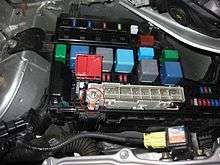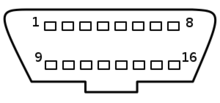Automobile Repair/Toyota/Prius
< Automobile Repair < ToyotaGeneral
This document refers to the Toyota Prius 2004-2009 (NHW20) and contains information only where details for the Prius differ from 'ordinary' vehicles. The Prius doesn't lend itself to home maintenance beyond the usual oil/coolant levels, tyres, etc. Almost everything electrical is computer controlled so special equipment is required to diagnose faults or change parameters. Also, worth mentioning, is the high voltage battery which can give a nasty jolt to anyone who takes liberties with it. Having said that, there are still steps that owners can take to minimise future problems and even some relatively minor problems that can be easily and safely fixed by the owner.
Electrical
Flat Battery!
The normal 12 volt battery, located in the back under the cover by the right hand wheel arch, is quite small and will discharge if the car isn't used for more than a couple of months. This battery is used only to maintain the memories of various in-car systems and to start the hybrid system when the driver needs the vehicle, there is no heavy starter motor to crank over which explains the small size of the battery. A total loss of power such as a flat or disconnected battery can cause unforeseen problems, these are not insurmountable or even serious but can be annoying. These issues need to be restored by clearing the error codes from the system (see below). A flat battery can also cause an embarrassing problem - access to the inside of the car can be difficult once the battery is flat if the owner hasn't taken care to use the manual key occasionally (locks seize up if not used so it's a very good idea to use the manual key once a month just to keep the locks working).

Jumpstarting the Prius
The Prius can be jumpstarted just like any other car. Access to the battery is not needed though, there is a jumpstart terminal hidden under a red plastic cover in the fusebox - this is located under the bonnet (or hood). Sufficient power from the donor vehicle is required to start the hybrid system, this is far less than a normal vehicles starter motor would require. Connect the +12 volt lead to this terminal, then the ground lead to any bare metal part in the engine compartment. Once that is done, just start the Prius as normal. The leads can then be disconnected, there is no need to leave them connnected once the hybrid system has started even if the engine hasn't fired up. This sometimes catches out drivers of recovery vehicles who think the Prius has failed to start or has stalled. WARNING: Do not attempt to push start a Prius and take great care to get the leads the right way round, mixing up the polarity (+ to -) WILL cause extremely expensive damage to your Prius.
Recharging the 12 volt battery
The 12 volt battery can be recharged using a standard car battery charger. The best way to charge the battery though, is to take the car for a drive, at least 20 minutes. Unlike normal cars, the Prius does not charge the 12 volt battery via an alternator spun by the engine. This vehicle charges its 12 volt battery directly via the hybrid system so if you are unable to take the car out for a run for any reason, just switching the system on for a while will do the job. Be aware that the engine will start occasionally to ensure the high voltage battery doesn't discharge - something to bear in mind if the car is parked in a closed garage. Doing this will also wreck your miles per gallon record...
Notes about the high voltage battery
The high voltage battery will never discharge under normal operating conditions. The Prius strives to keep the battery within normal parameters while the car is being driven and it is physically disconnected via a relay when the car is shut down. It is charged automatically by energy reclaimed by the hybrid system when the vehicle is slowing down and by running the main engine when required. Barring faults, the only way to discharge the high voltage battery is to run the car without fuel, thus preventing the engine starting. This is to be avoided except in emergencies and a specific warning is given in the vehicles handbook about this. If access is needed to the battery, there is a safety plug, close to the battery itself, which can be used to disconnect it completely for maintenance purposes. Having said that, there is no need for the average owner to go near that battery and it is not necessary to unplug it if you're not intending to use the car for some time.
The Diagnostic Trouble Codes

The Diagnostic Trouble Codes or DTC's (also known simply as fault codes) are stored automatically whenever any of the sensors are outside of predetermined parameters. For instance, on the Prius, there are sensors at the braking systems master cylinder and also at the calipers. If the sensors show different readings, the system logs this as a fault. The fault codes are not generally cleared automatically; they are stored until reset manually with an OBD-II diagnostic tester. If you have such a tool and wish to interrogate the system and/or reset the fault codes, you can just plug it in and follow the instructions for the particular tool you are using. If you don't have an OBD-II tester, you can get away with a Special Service Tool (SST) 09843-18040 from Toyota. This is used to safely link particular terminals together in order to get the system to display the stored fault codes and respond to instructions given via the vehicles sensors. Warning lights on the dashboard that refuse to extinguish even when you are sure there is no fault can be due to stored fault codes.
To clear the stored fault codes using the SST
- Use the SST to connect terminals 4 and 13 of the OBD-II socket.
- Turn on the vehicles power (just press the power button).
- Press the brake pedal at least eight times within five seconds.
- Check that there are no warnings displayed on the dashboard - if warnings are still displayed, turn the power off and repeat from step 2.
- Unplug the SST.
Radio - poor reception
Poor reception on the Prius, including crackling, on both AM and FM is usually a grounding problem at the antenna end. The antenna is mounted on the roof, right at the back in the centre. The fix then is simply to gain access, unbolt the antenna, clean the antenna and the area of the roof where it makes contact, smear some dielectric grease on the contact point to prevent corrosion in the future (petroleum jelly will suffice) and put it all back together. Unfortunately, in order to gain access to the contact point in order to clean it, you'll need to remove the rear internal light assembly and drop the headlining at the back.
Auto (power) function of electric windows not working
Disconnecting the 12 volt battery in a Prius (or allowing it to go flat), will cause the automatic function of the power windows to fail. They need to be recalibrated before they will work properly again. Fortunately this is an easy task. Just use the switch to lower the window to about half way. Then use the same switch to raise the window. Hold the switch in the (up) position for at least a second after the window stops moving. If that fails, try disconnecting the battery again for a few minutes, reconnect it and try again, holding the switch for a couple of seconds after the window stops.